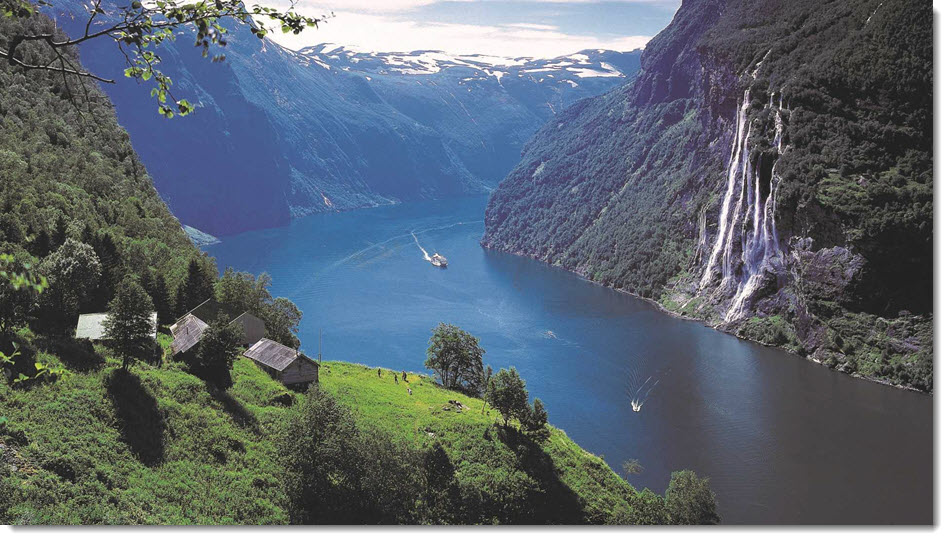
The Research Council and Enova announced their support for a project that will develop and pilot a hydrogen-powered, zero-emission catamaran vessel for combined passengers and car transport on the World Heritage Fjord in Geiranger.
Flakk og Brødrene Aa is behind the H2CarbonCat project, which aims to have a ferry ready for operational tests in the spring of 2023. SINTEF is the project’s primary R & D partner, and will use the knowledge base they have developed in the use of hydrogen and battery technology in transport. Research contributions will be based on experiences from relevant, past and present, projects with national and international roots. SINTEF contributes with system analysis, technology development and ship construction technology. In addition, SINTEF will integrate the value chain for hydrogen that is under development through the Hellesylt Hydrogen Hub project. Hexagon Composites and Gexcon are the other partners in the project.
The ferry will run from Hellesylt-Geiranger, which is very popular sightseeing route (220,570 passengers, 21,285 cars and 4,277 buses in 2018 – the season) . The Storting has decided that the World Heritage fjords will have emission-free traffic by 2026, an ambition this pilot project will ensure the realization of. According to DNV-GL, this ferry connection alone accounts for between 20 and 30 percent of the total (air) pollution on the Geirangerfjord. A conversion of the ferries to a zero-emission solution will be a significant contribution to reducing emissions in the fjord.
“We are proud to contribute to creating sustainable jobs through new technology that reduces emissions. Geiranger will soon be about even more than a fantastic nature, this ferry will be an attraction in itself . Here, we translate thoughts and knowledge about hydrogen into practical action for the green shift, together with forward-looking industrial partners. It is to fulfill our vision of technology for a better society” , says CEO Alexandra Bech Gjørv in SINTEF.
H2CarbonCat is funded by Pilot-E, which coordinates tools and will ensure that ideas come quickly from research to full scale. The goal for Pilot-E is to develop new, innovative solutions in the area of environmentally and climate-friendly energy technology. The projects are financed with funds from the Ministry of Trade and Industry, the Ministry of Petroleum and Energy, the Ministry of Climate and the Environment and the Ministry of Transport and Communications.
The ferry will be built in carbon fiber and will thus be more than 30 percent lighter than conventional ferries (including 150 tonnes of cargo). Energy consumption is reduced by more than 20 percent and increases the profitability and competitiveness of ships with this technology. The realization of this PILOT-E project will pave the way for a faster replacement rate for emission-free ferries, both nationally and internationally.
The project will show the establishment of a concrete hydrogen infrastructure in the North-West of Norway that uses hydrogen as an energy carrier. It can not be underestimated that the project could have a significant signal effect, by showing the way for zero-emission transport in a number of other areas such as speedboats / sightseeing boats, heavy transport, buses and trains.
“This year’s awards show that the Norwegian maritime industry is really at the forefront when it comes to developing emission-free solutions with great export potential. This is another great example of how we create new green industry and growth in Norway,” says Minister of Trade and Industry Iselin Nybø.
“This award is a good example of the leading technological competence that lies in the Norwegian maritime industry. These are three innovative projects that will help to restructure the maritime industry and ensure less emissions both in Norway and internationally. I am glad that the government’s investment in hydrogen helps to support such projects. Pilot-E is an accurate tool that leads to concrete results,” says Minister of Petroleum and Energy Tina Bru.
“Green shipping is an area in which the government is investing heavily, and where Norway has a leading position. It gives us both emission cuts and Norwegian jobs. We must facilitate more zero-emission fuel to get the necessary restructuring in shipping. The projects that now receive support through Pilot-E will make important contributions to developing hydrogen and ammonia as alternative zero-emission fuels for various vessel categories,” says Minister of Climate and Environment Sveinung Rotevatn.
Source: SINTEF
Read the most up to date Fuel Cell and Hydrogen Industry news at FuelCellsWorks




